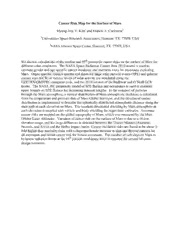
NASA Technical Reports Server (NTRS) 20110942677: Cancer Risk Map for the Surface of Mars PDF
Preview NASA Technical Reports Server (NTRS) 20110942677: Cancer Risk Map for the Surface of Mars
Cancer Risk Map for the Surface of Mars Myung-Hee Y. Kim1 and Francis A. Cucinotta2 1Universities Space Research Association, Houston, TX 77058, USA 2NASA Johnson Space Center, Houston, TX 77058, USA We discuss calculations of the median and 95th percentile cancer risks on the surface of Mars for different solar conditions. The NASA Space Radiation Cancer Risk 2010 model is used to estimate gender and age specific cancer incidence and mortality risks for astronauts exploring Mars. Organ specific fluence spectra and doses for large solar particle events (SPE) and galactic cosmic rays (GCR) at various levels of solar activity are simulated using the HZETRN/QMSFRG computer code, and the 2010 version of the Badhwar and O’Neill GCR model. The NASA JSC propensity model of SPE fluence and occurrence is used to consider upper bounds on SPE fluence for increasing mission lengths. In the transport of particles through the Mars atmosphere, a vertical distribution of Mars atmospheric thickness is calculated from the temperature and pressure data of Mars Global Surveyor, and the directional cosine distribution is implemented to describe the spherically distributed atmospheric distance along the slant path at each elevation on Mars. The resultant directional shielding by Mars atmosphere at each elevation is coupled with vehicle and body shielding for organ dose estimates. Astronaut cancer risks are mapped on the global topography of Mars, which was measured by the Mars Orbiter Laser Altimeter. Variation of cancer risk on the surface of Mars is due to a 16-km elevation range, and the large difference is obtained between the Tharsis Montes (Ascraeus, Pavonis, and Arsia) and the Hellas impact basin. Cancer incidence risks are found to be about 2- fold higher than mortality risks with a disproportionate increase in skin and thyroid cancers for all astronauts and breast cancer risk for female astronauts. The number of safe days on Mars to be below radiation limits at the 95th percent confidence level is reported for several Mission design scenarios.
